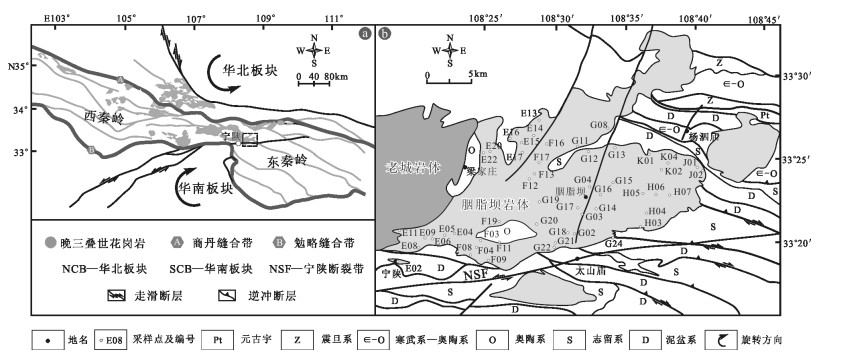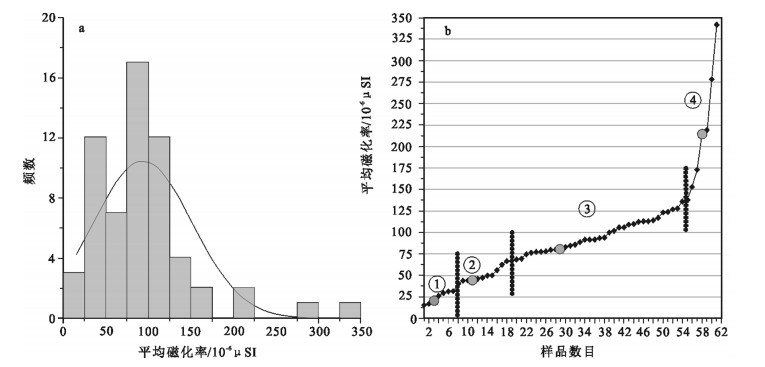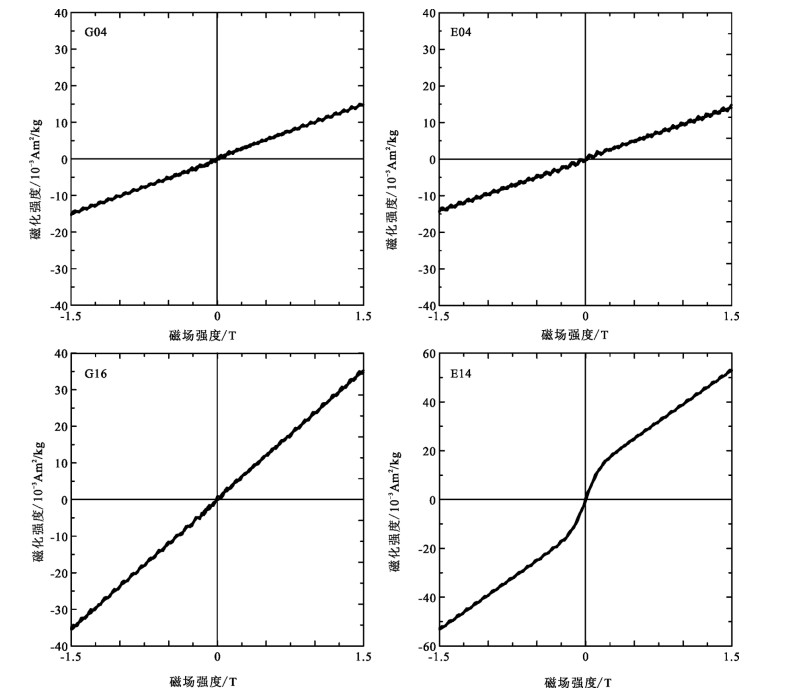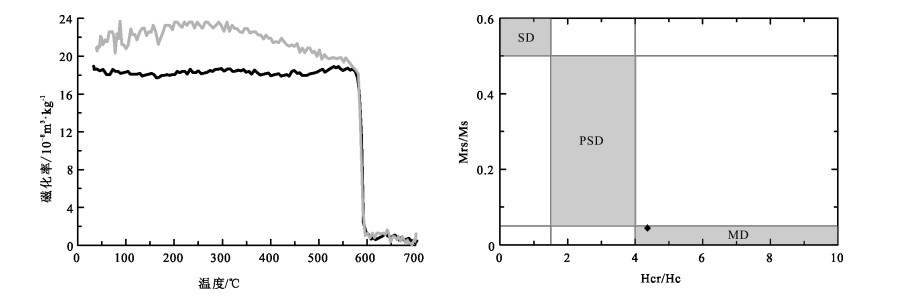Magnetic mineralogy and fabric reliability constraints of Late Triassic Yanzhiba pluton in South Qinling Mountain
-
摘要:
胭脂坝岩体是秦岭造山带内具典型代表性意义的晚三叠世花岗岩,已有的年代学和地球化学研究对该岩体的侵位机制有不同认识。对岩体的岩石磁学进行分析,结合其岩相学特征,探讨了用磁组构约束岩体内部组构这一方法的可靠性。研究表明,胭脂坝岩体样品的平均磁化率Km值和校正磁化率各向异性度PJ值总体较低,与顺磁性花岗岩类一致。磁滞回线分析表明,绝大部分样品的磁化率来自顺磁性矿物的贡献,少部分高磁化率样品含有铁磁性矿物的贡献,但其浓度极低。高磁化率值样品的等温剩磁曲线获得和反向退磁曲线及χ-T曲线分析表明,铁磁性矿物为磁铁矿,且为多畴颗粒。结合岩相学特征,认为胭脂坝岩体低场磁组构反映了顺磁性的云母类矿物的组构特征,磁组构特征真实地记录了样品的内部组构特征。
Abstract:The Yanzhiba pluton is one of the typical Late Triassic granite plutons in Qinling Mountain, and lots of geochronological and geochemical work has been done for the Yanzhiba granite pluton in South Qinling Mountain recently. However, opinions of its tectonic settings are contradictory. Some recent studies have placed some new constraints on this problem based on the magnetic fabrics of these granite plutons. These studies have successfully elucidated the correlation between regional tectonics and granite emplacement. However, the reliability of the magnetic fabric method has not been specifically studied. In this paper, the authors present an elaborate magnetic mineralogy analysis, combined with previous petrographical data, to shed light on this problem. Mean susceptibility Km and corrected anisotropy degree PJ of Yanzhiba pluton are low, which are consistent with data of paramagnetic granite. Hysteresis loops show that susceptibility of most samples originates from paramagnetic minerals, with a small portion of ferrimagnetic contribution, whose concentration, however, is very low. Isothermal remanent magnetization acquisition (IRM) and DC-Field demagnetization curves show that the ferrimagnetic component in pluton is mainly soft magnetic minerals, and χ-T curves confirm that it is magnetite. The hysteresis parameter ratios on Day plot further indicate multi-domain magnetite. The results obtained by the authors prove that the magnetic fabric result from Yanzhiba pluton is reliable and has recorded actual mica fabrics.
-
Keywords:
- AMS /
- IRM /
- hysteresis loops /
- thermomagnetic analyses /
- ferrimagnetic minerals /
- paramagnetic grantie
-
致谢: 本研究工作得到西北大学地质学系(大陆动力学国家重点实验室)张国伟教授的指导与帮助,成稿过程中得到陕西区域地质矿产研究院李海平教授级高工的悉心指导,磁组构数据测试得到西北大学地质学系(大陆动力学国家重点实验室)王建其老师的帮助,岩石磁学实验及解释分析得到中国科学院地质地球物理研究所(岩石圈演化国家重点实验室)靳春胜副研究员的指导,在此一并表示衷心的感谢。
-
-
Vigneresse J L. Should felsic magmas be considerded as tectonic objects, just like faults or folds[J]. Journal of Structural Geology, 1999, 21:1125-1130. doi: 10.1016/S0191-8141(99)00102-9 Vigneresse J L. Should felsic magmas be considerded as tectonic objects, just like faults or folds[J]. Journal of Structural Geology, 1999, 21:1125-1130. doi: 10.1016/S0191-8141(99)00102-9
Petford N, Cruden A R, McCaffrey, et al. Granite magma formation, transport and emplacement in the Earth's crust[J]. Nature, 2000, 408:669-673. doi: 10.1038/35047000 Petford N, Cruden A R, McCaffrey, et al. Granite magma formation, transport and emplacement in the Earth's crust[J]. Nature, 2000, 408:669-673. doi: 10.1038/35047000
Bouchez J L, Hutton D H W, Stephens W E, et al. Granite:From Segregation of Melt to Emplacement Fabrics[M]. Kluwer Academic Publishers, Dordrecht, 1997:95-112. Bouchez J L, Hutton D H W, Stephens W E, et al. Granite:From Segregation of Melt to Emplacement Fabrics[M]. Kluwer Academic Publishers, Dordrecht, 1997:95-112.
郭秀峰, 张国伟, 梁文天, 等.南秦岭金池院与张家坝岩体磁组构特征和构造意义[J].地质论评, 2009, 55(3):436-443. http://www.cnki.com.cn/Article/CJFDTOTAL-DZLP200903018.htm 梁文天.秦岭造山带东西秦岭交接转换区陆内构造特征及演化过程[D].西北大学博士学位论文, 2009. http://cdmd.cnki.com.cn/article/cdmd-10697-2009088411.htm 谢晋强, 张国伟, 鲁如魁, 等.西秦岭温泉岩体的磁组构特征及其侵位机制意义[J].地球物理学报, 2010, 53(5):1187-1195. http://www.cnki.com.cn/Article/CJFDTOTAL-DQWX201005022.htm Liang W T, Zhang G W, Bai Y, et al. Newinsights into the emplacement mechanism of the Late Triassic granite plutons in the Qinling orogen:A structural study of the Mishuling Pluton[J]. GSA Bulletin, 2015,127(11/12):1583-1603. Liang W T, Zhang G W, Bai Y, et al. Newinsights into the emplacement mechanism of the Late Triassic granite plutons in the Qinling orogen:A structural study of the Mishuling Pluton[J]. GSA Bulletin, 2015, 127(11/12):1583-1603.
Tarling D H, Hrouda F. The Magnetic Anisotropy of Rocks[M]. Chapman & Hall, London, 1993:1-217. Tarling D H, Hrouda F. The Magnetic Anisotropy of Rocks[M]. Chapman & Hall, London, 1993:1-217.
梁文天, 靳春胜, Prayath N, 等.秦岭造山带晚三叠世糜署岭岩体的岩石磁学及磁组构可靠性约束[J].地球物理学报, 2015, 58(3):953-970. http://www.cnki.com.cn/Article/CJFDTOTAL-DQWX201503021.htm Jiang Y H, Jin G D, Liao S Y, et al. Geochemical and Sr-Nd-Hf isotopic constraints on the origin of Late Triassic granitoids from the Qinling orogen, central China:implications for a continental arc to continent-continent collision[J]. Lithos, 2010, 117:183-197. doi: 10.1016/j.lithos.2010.02.014 Jiang Y H, Jin G D, Liao S Y, et al. Geochemical and Sr-Nd-Hf isotopic constraints on the origin of Late Triassic granitoids from the Qinling orogen, central China:implications for a continental arc to continent-continent collision[J]. Lithos, 2010, 117:183-197. doi: 10.1016/j.lithos.2010.02.014
Dong Y P, Liu, X M, Zhang G W, et al. Triassic diorites and granitoids in the Foping area:Constraints on the conversion from subduction to collision in the Qinling orogen, China[J]. Journal of Asian Earth Sciences, 2012, 47:123-142. doi: 10.1016/j.jseaes.2011.06.005 Dong Y P, Liu, X M, Zhang G W, et al. Triassic diorites and granitoids in the Foping area:Constraints on the conversion from subduction to collision in the Qinling orogen, China[J]. Journal of Asian Earth Sciences, 2012, 47:123-142. doi: 10.1016/j.jseaes.2011.06.005
Yang P T, Liu S W, Li Q G, et al. Geochemistry and zircon UPb-Hf isotopic systematics of the Ningshan granitoid batholith, middle segment of the south Qinling belt, Central China:Constraints on petrogenesis and geodynamic processes[J]. Journal of Asian Earth Sciences, 2012, 61:166-186. doi: 10.1016/j.jseaes.2012.09.013 Yang P T, Liu S W, Li Q G, et al. Geochemistry and zircon UPb-Hf isotopic systematics of the Ningshan granitoid batholith, middle segment of the south Qinling belt, Central China:Constraints on petrogenesis and geodynamic processes[J]. Journal of Asian Earth Sciences, 2012, 61:166-186. doi: 10.1016/j.jseaes.2012.09.013
刘树文, 杨朋涛, 李秋根, 等.秦岭中段印支期花岗质岩浆作用与造山过程[J].吉林大学学报:地球科学版, 2011, 41(6):1928-1943. http://www.cnki.com.cn/Article/CJFDTOTAL-CCDZ201106022.htm 骆金城, 赖绍聪, 秦江锋, 等.南秦岭晚三叠世胭脂坝岩体的地球化学特征及地质意义[J].地质论评, 2010, 56(6):792-800. http://www.cnki.com.cn/Article/CJFDTOTAL-DZLP201006005.htm 陶威, 梁文天, 张国伟.南秦岭晚三叠世胭脂坝岩体的磁组构特征及意义[J].吉林大学学报(地球科学版), 2014, 44(5):1575-1586. http://www.cnki.com.cn/Article/CJFDTOTAL-CCDZ201405015.htm 陶威.南秦岭晚三叠世老城与胭脂坝花岗岩体的侵位机制及动力学意义[D].西北大学硕士学位论文, 2014. http://cdmd.cnki.com.cn/article/cdmd-10697-1014253567.htm Day R, Fuller M, Schmidt V A. Hysteresis properties of titanomagnetite:Grain size and compositional dependence[J]. Phys. Earth Planet. Inter., 1977, 13:260-266. doi: 10.1016/0031-9201(77)90108-X Day R, Fuller M, Schmidt V A. Hysteresis properties of titanomagnetite:Grain size and compositional dependence[J]. Phys. Earth Planet. Inter., 1977, 13:260-266. doi: 10.1016/0031-9201(77)90108-X
Grégoire V, Darrozes J, Gaillot P, et al. Magnetite grain shape fabric and distribution anisotropy vs rock magnetic fabric:a three-dimensional case study[J]. Journal of Structural Geology, 1998, 20:937-944. doi: 10.1016/S0191-8141(98)00022-4 Grégoire V, Darrozes J, Gaillot P, et al. Magnetite grain shape fabric and distribution anisotropy vs rock magnetic fabric:a three-dimensional case study[J]. Journal of Structural Geology, 1998, 20:937-944. doi: 10.1016/S0191-8141(98)00022-4




 下载:
下载:





